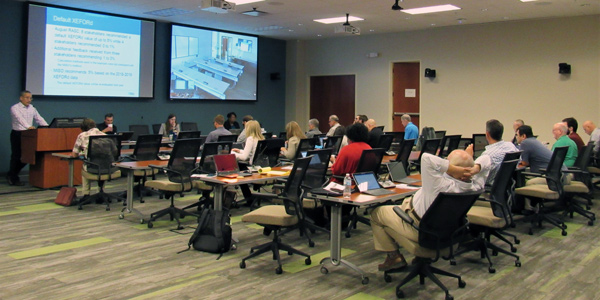By Amanda Durish Cook
CARMEL, Ind. — MISO plans to hold a final Order 841 workshop on Oct. 10 to complete its collection of stakeholder opinions on its storage participation model, which will include an agreement for distribution-level storage but leave storage dispatch optimization to a later filing.
Here’s what the RTO has decided thus far.
Pro Forma for Distribution-connected Storage
MISO’s draft pro forma agreement for storage connected at the distribution level requires storage:
- Be registered and modeled in MISO;
- Secure agreements with distribution facilities so energy can be delivered to the MISO transmission system;
- Be able to receive MISO operating instructions; and
- Provide MISO with facility measurements and settlement meter data.
The agreement also specifies that MISO will make sure a storage resource owner isn’t charged twice for energy when it pays retail rates for wholesale charging. MISO said it will exclude the charging energy from wholesale rates in its settlements.
During a Sept. 13 Market Subcommittee meeting, Coalition of Midwest Power Producers CEO Mark Volpe asked if the agreement opens an avenue for distribution-connected storage assets to avoid MISO’s interconnection queue.
“This is not a way to circumvent the interconnection queue,” Director of Market Design Kevin Vannoy said.
“So you’re saying that distribution-level storage must go through the interconnection queue?” Volpe asked.
“I don’t have a definitive answer for that,” Vannoy responded.
Consumers Energy’s Jeff Beattie pointed out that many qualifying facilities that utilities must purchase power from under the Public Utility Regulatory Policies Act are connected at the distribution level.
Canned Corn
The Energy Storage Association’s Rao Konidena, formerly a MISO adviser, brought a can of corn with him to the MSC podium.
Storage, he said, is like a can of corn.
“We know what’s in there; we know how it’s used,” he said. MISO’s remaining piece is finalizing storage rules for an asset whose purpose is already understood. He said storage owners should be able to toggle hourly between offering energy and ancillary services and have the option to self-dispatch.
Konidena said storage asset owners must be able to enter offline mode without fear of being cited for physical withholding. “We need to have enough clarity to know that asset owners will not be penalized as they come back online,” he said.
No Optimization Yet
MISO is not ready to optimize storage resources’ energy schedules in the day-ahead or real-time markets. That means the RTO won’t pick the best and most economic hours for a battery or other storage resource to charge or discharge.
MISO said it will commit and dispatch storage respecting minimum and maximum charge limits and any self-scheduled offers. But it said its unit commitment calculations cannot be easily changed to optimize storage in charge/discharge or continuous modes across multiple periods.
Vannoy said participation must be accommodated per Order 841, but MISO should not have to change existing market services to accommodate storage. He also said FERC’s order has already suggested that storage resources will represent their energy limitations through offer prices.
“We don’t see it as a requirement of 841 that we change our optimization calculation,” Vannoy said. “We’re taking this into our research and development, and it will become more important as storage becomes more prevalent. But right now, we’re not prepared given the timeline, nor is it required in our mind.”
Storage Capacity
Meanwhile, MISO is moving forward on a multistep capacity determination process for storage resources.
The process involves a test verifying the storage facility’s capacity and its transmission deliverability. The resource must provide quarterly reports to MISO’s generating availability data system (required for storage resources 10 MW and up). The RTO will use the data to calculate an equivalent forced outage rate, installed capacity and unforced capacity for the resource.
Storage resources that are designed with limited output availability will also have to submit a day-ahead must-offer for at least four continuous hours covering the two hours before the peak, the peak hour and the hour following the peak hour. MISO forecasts its daily peak hour seven days in advance.
MISO revealed this version of the plan last month to comply with Order 841. (See MISO Fills out Storage Capacity Plan.)
“It’s not really unique to storage capacity resources,” Senior Adviser of Capacity Market Administration Rick Kim said of the proposed accreditation process during a Sept. 12 Resource Adequacy Subcommittee meeting.
But Customized Energy Solutions’ David Sapper said the storage must-offer rule for use-limited resources might be too restrictive for an RTO that is trying to place more emphasis on supply flexibility in an environment where a peak risk can occur in during several different hours, not just the summer peak hour that MISO currently plans around. (See MISO Looks to Members for Load Forecasting Ideas.)
“It ignores the operational characteristics of storage,” Sapper said.
Vannoy pointed out that the use-limited description is an optional designation, left up to the owners of storage resources. He said even use-limited storage resources are free to offer for 24 continuous hours.
MISO plans to introduce draft Tariff language for storage capacity credit at next month’s MSC, Kim said.





